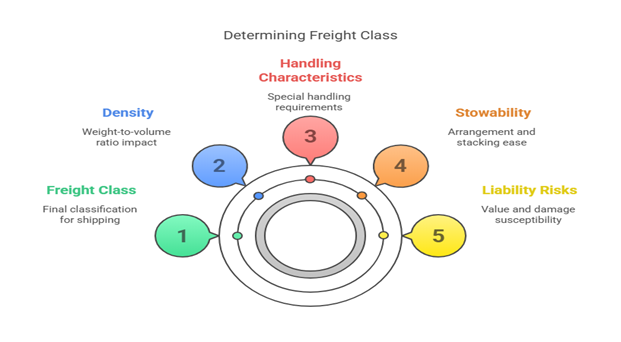If you’ve ever tried to ship something without knowing its exact freight class or NMFC code, you’ve probably experienced unexpected fees or frustrating delays. In Less-Than-Truckload (LTL) shipping, understanding freight classification and NMFC codes is essential. The National Motor Freight Classification (NMFC) system assigns specific codes and classes to different types of freight, which helps determine shipping costs and ensures proper handling. In this guide, we’ll explore the importance of NMFC codes, how to determine freight class, and where to find essential tools like an NMFC code lookup free service.
What is NMFC in Shipping?
LTL freight class is a standardized system that categorizes shipments based on their characteristics. The freight class affects shipping rates, handling procedures, and insurance costs. Factors that determine an LTL freight class include weight, dimensions, density, and the item’s susceptibility to damage. Understanding what is NMFC class and using an NMFC number lookuptool can help businesses ensure their shipments are classified correctly (Freightquote, n.d.).

“Accurate freight class assignment is foundational to avoiding unnecessary accessorial fees and ensuring shipment integrity.”
How to Determine Freight Class
Freight is classified into one of 18 different freight classes, ranging from class 50 (least expensive) to class 500 (most expensive). Determining the right classification is key to getting an accurate shipping quote. Several factors affect freight class codes, including:
Density (Weight-to-Volume Ratio): The density of freight is determined by dividing its weight by its cubic volume. High-density items generally fall into lower freight class codes, which means lower shipping costs.
For example, a 500-pound pallet of compact steel rods might be classified as class 50, while a 500-pound shipment of bulky plastic furniture may fall under class 200 due to its lower density. Using an NMFC number lookup tool can help confirm the correct class.
- Handling Characteristics: Items that require special handling due to fragility, shape, or hazardous properties often fall into higher shipping classes.
For example, a shipment of fragile glass panels may be classified as freight class 175, while a stack of sturdy wooden crates might be classified as class 70. The NMFC classification lookup ensures that each item is placed in the appropriate category.
- Stowability (How Well It Fits with Other Shipments): Freight that is easy to stack and arrange within a trailer typically has a lower NMFC freight class. Items that are oddly shaped, require extra space, or cannot be stacked due to safety concerns will have a higher classification.
For example, a pallet of uniformly stacked bricks could be freight class 55, whereas a large, irregularly shaped sculpture may be classified as class 300. Using an NMFC code lookup free tool helps determine the best classification.
- Liability Risks: The value and susceptibility of a product to damage or theft affect its freight class. High-value electronics, fragile antiques, or perishable food products are often assigned higher freight class codes to account for increased insurance and handling requirements.
For example, an expensive flat-screen TV might be freight class 250, while a bulk shipment of low-value paper towels might be class 65. Checking an NMFC item number lookup can help businesses ensure accurate classification.
Using an NMFC number lookup tool for shippers can help identify the right classification. Resources like an NMFC code lookup free tool allow businesses to find accurate shipment codes. Misclassifications can result in surcharges averaging 25% of the original shipping cost (Logistics Management, 2024).

“Knowing how to calculate density and use the NMFC code properly can prevent costly reclassification and delays.”
How do you think freight classification impacts shipping costs and carrier pricing structures?
How to Determine NMFC Code for Your LTL Shipment
To accurately classify your freight, you must determine the correct NMFC code. This can be done through an NMFC item number lookup tool or an NMFC classification lookup service. The NMFC code is assigned based on the shipment’s characteristics, including:
Material Composition: The type of material affects the NMFC code. For instance, a shipment of steel bars has a lower NMFC freight class than a shipment of foam insulation panels because steel is denser and more durable.
Packaging Method: The way items are packaged influences their classification. Crated machinery is often easier to transport than loose or irregularly packed items, resulting in a lower freight class.
Value and Liability: High-value goods like medical devices may fall into a higher NMFC class due to the increased risk of damage or theft.
Handling Requirements: Items requiring special handling, such as refrigerated goods, often have a unique NMFC number.
For example:
Depending on weight and packaging, a wooden chair could fall under an NMFC code around class 150.
A motor engine, being heavy and compact, would typically be assigned an NMFC code in class 85.
Foam mattresses, which are lightweight but bulky, could be classified as class 250 or higher.
An NMFC lookup tool can help you verify the NMFC code for class 50 or any other class your freight falls under.
“Accessing the right NMFC code is critical—it determines your rate, legal classification, and risk exposure.”
What challenges do businesses face when determining the correct NMFC code for their shipments, and how can technology help simplify this process?
Standard Freight Classes and Their NMFC Codes
To illustrate the significance of NMFC classification lookup, let’s examine some standard freight classes and examples:
- Class 50 Freight: The least expensive, often for durable items that are dense and easy to transport. Example: Heavy steel beams.
- Freight Class 55: Slightly higher in cost due to variations in density and handling. Example: Small machinery parts.
- Freight Class 60: Often assigned to items with moderate density, requiring careful handling. Example: Industrial motors.
- Freight Class 65: This includes shipments that need more space or specialized handling. Example: Bagged coffee beans.
- Freight Class 70: Falls within mid-range pricing and may require more careful stowing. Example: Wooden furniture.
- Freight Class 85: This is Common for items with moderate density and handling needs. Example: Automobile engines.
- Freight Class 100: Includes items that require more space but are not highly fragile. Example: Bicycles.
- Freight Class 125: Higher cost due to size and fragility. Example: Refrigerators.
- Freight Class 150: Common for large but lightweight items. Example: Plastic storage bins.
- Freight Class 175: Includes fragile items requiring careful handling. Example: Glass panels.
- Freight Class 200-250: Typically assigned to bulky, lightweight, or high-value items. Example: Foam mattresses.
- Freight Class 300-500: The most expensive due to handling and liability concerns. Example: Antiques, artwork, and delicate electronics.
Using an NMFC item number lookup tool can help businesses identify the exact classification needed for their products (Freightquote, n.d.).
“Freight classes aren’t just numbers—they directly impact your profit margins on every shipment.”
Looking for help classifying your freight? Explore our shipping services to understand our brokerage services.
Finding NMFC Codes and Freight Classification Tools
If you’re new to LTL shipping, it’s important to have access to reliable resources like an NMFC lookup or NMFC number lookup tool. These tools simplify the process by providing the correct NMFC classification lookup to ensure accuracy in shipping documentation and pricing.
Here are some helpful tools and resources for determining NMFC codes and freight class:
Freight Software Platforms: Comprehensive solutions like TMS (Transportation Management Systems) often include built-in NMFC code tools and shipping classes references.
NMFC Code Lookup Tools: These allow you to search for specific NMFC codes based on your product type. Many services offer an NMFC code lookup free feature to help you identify the correct classification.
NMFC Item Number Lookup: Use this to identify the exact NMFC item number associated with your freight. It’s useful when you already have a general idea of your freight’s classification but need to get precise.
Freight Class Calculators: Many third-party logistics (3PL) providers offer online calculators to help figure freight class based on weight, dimensions, and density.
Freight Classification Chart: This is a helpful reference for comparing freight class codes and assessing your shipment’s performance.
Carrier or Broker Tools: Some LTL carriers and brokers provide their versions of NMFC lookup platforms, often integrated into their shipping portals.

By combining these tools, shippers can accurately determine what NMFC is, select the correct class, and avoid costly misclassifications.
Using an NMFC lookup tool can reduce reclassification disputes by up to 30% (FreightWaves, 2024).
“Digital tools are now indispensable—manual guesswork is no longer acceptable in modern logistics.”
How do digital freight classification tools enhance efficiency and reduce costs in logistics management?
Why Are NMFC Codes Important for Your LTL Shipment?
Using the correct NMFC number is critical for accurate billing, preventing reclassification fees, and ensuring efficient transit. Incorrect classification can lead to costly adjustments and delays. By utilizing an NMFC number lookup and a freight classification chart, businesses can avoid unnecessary shipping charges and disputes.
Misclassifying freight can lead to costly reclassifications, incorrect pricing, and potential delivery delays. By using resources such as an NMFC code lookup free tool or a freight classification chart, shippers can prevent errors and streamline logistics.
According to DAT Freight & Analytics, classification disputes can delay freight by up to 72 hours (DAT Freight & Analytics, 2024).
“One wrong NMFC code could cost you hundreds—accuracy is not optional.”
Looking for back-office support to ensure your NMFC codes are accurate and compliant? Explore our freight brokerage support services
Simplify LTL Shipping
Whether you’re looking for a freight class chart, need to figure freight class, or conduct an NMFC code lookup, understanding NMFC freight class is essential in LTL shipping. By leveraging tools like an NMFC number lookup and staying informed about shipping classes, businesses can optimize shipping efficiency, reduce costs, and avoid classification disputes.
You can ensure smooth and cost-effective LTL freight shipping by using accurate freight class codes, referring to an NMFC lookup, and understanding what NMFC class is.
Ready to streamline your LTL shipments? Contact us to discover how mastering NMFC freight class can save time and reduce your shipping costs.
References
DAT Freight & Analytics. (2024). the impact of freight classification errors. Retrieved from https://www.dat.com
Freightquote. (n.d.). Freight class and NMFC guide. Retrieved from https://www.freightquote.com
FreightWaves. (2024). Data insights on LTL reclassification rates. Retrieved from https://www.freightwaves.com
Logistics Management. (2024). Freight audit and reclassification trends. Retrieved from https://www.logisticsmgmt.com
National Motor Freight Traffic Association. (n.d.). National Motor Freight Classification. Retrieved from https://www.nmfta.org




